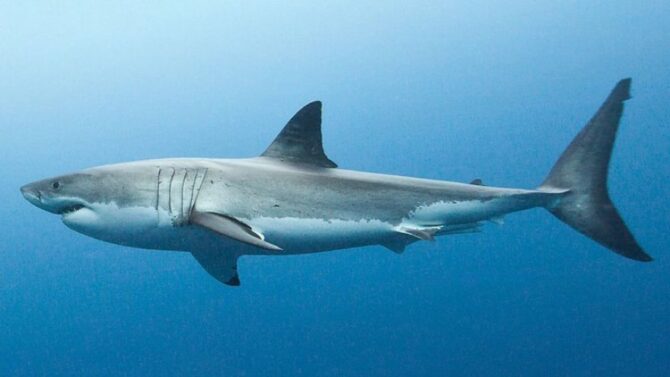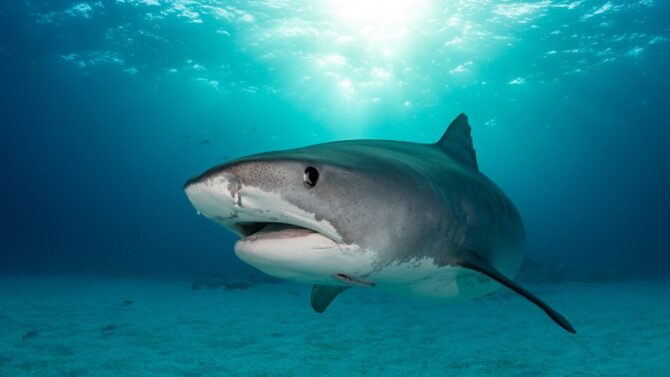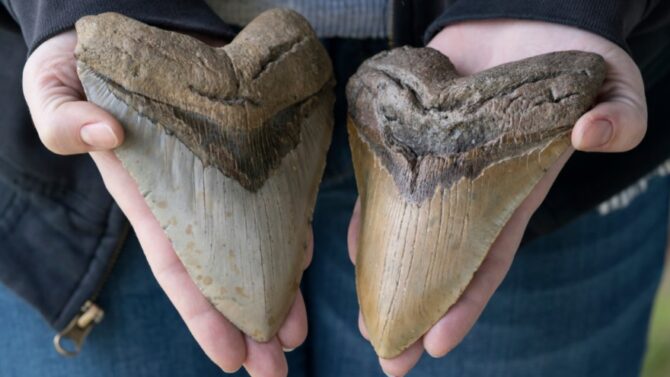Sharks, for many, are synonymous with fear, largely due to their portrayal in movies and media. Yet, the reality is far from this perception.
Most sharks are not only harmless to humans but are also fascinating creatures deserving of our admiration and respect. In my upcoming blog post, I delve deep into the world of these misunderstood marine giants.
I’ll introduce you to 10 of the least dangerous sharks, shedding light on their unique characteristics, from their sizes and diets to their preferred habitats and temperaments. Drawing from personal experiences and extensive research, I’ll also share invaluable insights and tips on how to safely coexist and interact with these magnificent creatures.
Join me on this enlightening journey, as we debunk myths and foster a deeper appreciation for sharks.
10. Leopard Shark
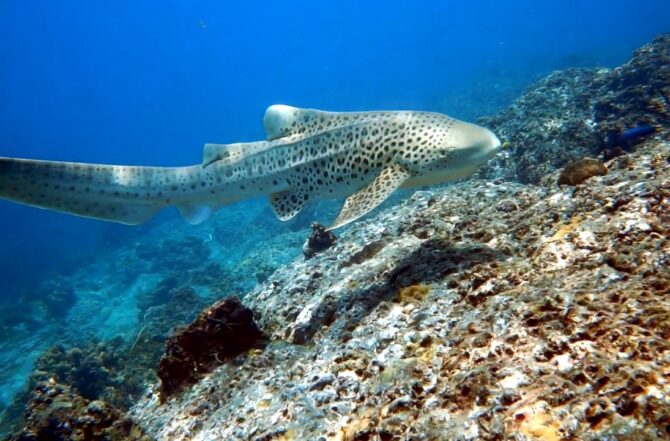
The leopard shark, with the scientific name Triakis semifasciata, is a slender and smaller species of shark, usually reaching lengths of about 5 feet. They are named for their distinctive leopard-like spots and stripes.
These sharks inhabit the coastal waters stretching from California to Mexico. Being nocturnal predators, they primarily feed during the night on fish, crabs, and shrimp.
Leopard sharks pose little to no threat to humans and can often be seen gracefully swimming near the water’s surface, especially during their migratory patterns.
9. Angel Shark
The Angel Shark is a testament to the art of camouflage. Resembling the sandy ocean floor, this bottom-dwelling shark is often mistaken for a ray due to its flattened body.
Measuring up to 5 feet in length, the Angel Shark is found in shallow tropical and subtropical waters across the globe. Unlike the typical image of a fast-moving, aggressive shark, the Angel Shark is an ambush predator.
It lies in wait, perfectly camouflaged against the seabed, ready to pounce on unsuspecting prey like fish, crabs, and lobsters. Despite their predatory nature, Angel Sharks pose little threat to humans and can often be observed resting peacefully on the ocean floor.
8. Bamboo Shark
Slender and graceful, the Bamboo Shark is a nocturnal beauty of the tropical seas. Growing to about 3 feet in length, these sharks are characterized by their distinctive banded appearance, reminiscent of bamboo stalks.
As night falls, the Bamboo Shark comes alive, prowling the shallow tropical and subtropical waters in search of its favorite meals: fish, crabs, and shrimp. Their non-aggressive nature and tendency to swim close to the seabed make them a favorite among divers and marine enthusiasts.
7. Goblin Shark

Venture into the abyssal depths of the Pacific and Atlantic Oceans, and you might just encounter the elusive Goblin Shark. With a peculiar elongated snout and a jaw that can protrude to snatch prey, the Goblin Shark is truly a sight to behold.
Growing up to 10 feet long, these deep-sea dwellers are rarely seen by humans, adding to their enigmatic reputation. Despite their somewhat intimidating, or should I say ugly appearance, Goblin Sharks are not considered dangerous to humans.
6. Greenland Shark

The icy waters of the Arctic and North Atlantic Oceans are home to the Greenland Shark, a true marvel of the marine world. Not only is this species the longest-living vertebrate on Earth, with some individuals believed to live for over 400 years, but it’s also one of the largest shark species, reaching lengths of up to 20 feet.
Greenland Sharks are slow-moving giants, leisurely cruising the cold depths in search of prey, which includes fish, seals, and even whales. While they are not typically aggressive towards humans, a bite from a Greenland Shark can be particularly nasty due to the bacteria present in their mouths.
5. Spiny Dogfish
The Spiny Dogfish, with its distinctive spines and sleek body, is a frequent traveler of the world’s temperate and cold-temperate waters. Measuring up to 3 feet in length, this small shark is a common sight in many marine ecosystems.
Unlike some of its more selective relatives, the Spiny Dogfish isn’t picky about its meals. As scavengers and opportunistic predators, they have a varied diet, feasting on fish, crustaceans, and mollusks.
While they aren’t known to be aggressive towards humans, it’s wise to approach them with caution. They are considered a dangerous predator in Chesapeake Bay as their sharp teeth can deliver a painful bite if threatened.
4. Sand Tiger Shark
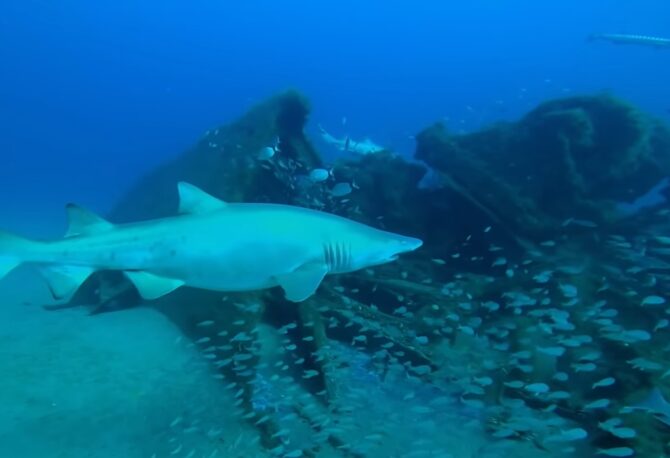
Lurking in the coastal waters from New Jersey to Florida, the Sand Tiger Shark is a formidable presence. This medium-sized shark, growing up to 10 feet long, has a somewhat fierce appearance with its protruding teeth, but it’s largely misunderstood.
Primarily nocturnal, Sand Tiger Sharks come alive at night, hunting fish, crabs, and shrimp in the coastal shallows. And while they aren’t typically aggressive towards humans, it’s essential to remember that their sharp teeth can inflict a painful bite if they feel threatened.
3. Basking Shark
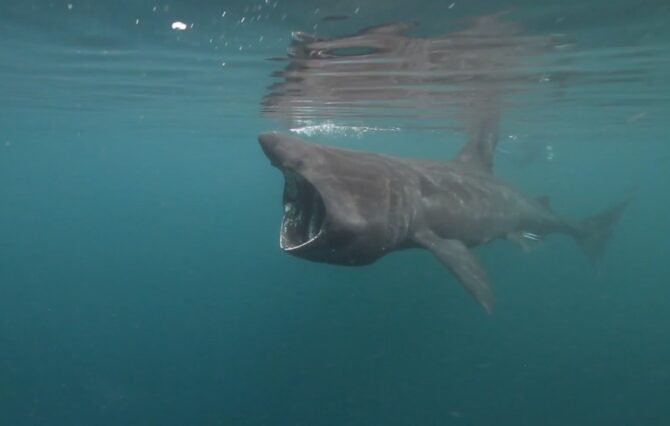
The basking shark, or Cetorhinus maximus, is the second largest fish in the world, trailing only behind the whale shark. They can grow up to an impressive 33 feet in length.
Much like the whale shark, the basking shark is also a filter feeder. It has a unique feeding habit where it swims with its enormous mouth wide open, filtering plankton and small fish from the water using its gill rakers. These sharks are typically found in temperate and cold-temperate waters globally.
Their slow-moving nature and tendency to ‘bask’ near the water’s surface give them their name.
2. Nurse Shark

The nurse shark, scientifically known as Ginglymostoma cirratum, is a smaller species of shark, usually growing to about 8 feet in length. These sharks are bottom-dwellers, often found in shallow tropical and subtropical waters.
They have a varied diet, functioning as scavengers and opportunistic predators. This means they consume a wide range of prey, from fish to crustaceans and mollusks.
Nurse sharks are known for their docile nature. They are not typically aggressive towards humans and can often be observed resting near reefs or in shallow waters.
1. Whale Shark
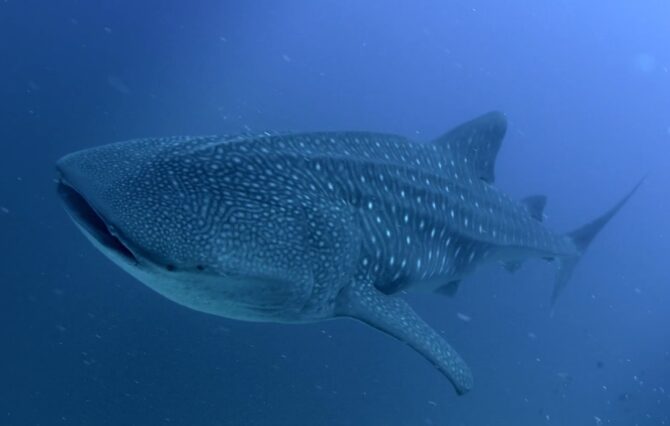
The whale shark, known scientifically as Rhincodon typus, holds the title of the largest fish on Earth. These magnificent creatures can reach staggering lengths of up to 40 feet.
Despite their intimidating size, they are known to be gentle giants. Their primary diet consists of plankton and small fish. Unlike many other sharks, whale sharks are filter feeders.
This means they have a unique feeding mechanism where they strain tiny food particles from the water using specialized structures called gill rakers. These sharks prefer tropical and warm temperate waters and can be found in various oceans around the world.
Their gentle nature and majestic appearance make them a favorite among divers and marine enthusiasts.
Tips for Safe Encounters with Least Dangerous Sharks
The ocean is a vast and wondrous place, home to a myriad of creatures, including sharks. While many shark species pose little to no threat to humans, it’s always essential to be prepared and informed.
Here are some tips to ensure safe encounters:
- Stay Informed: Before diving into the ocean, research the types of sharks that inhabit the area. Knowledge is your best defense.
- Avoid Known Shark Habitats: Some areas are known hotspots for shark activity. It’s best to avoid swimming or diving in these regions.
- Never Go Alone: There’s safety in numbers. Always swim or dive with a buddy.
- Stay Vigilant: While enjoying the ocean’s beauty, always be aware of your surroundings. If you spot a shark, remain calm and slowly move away.
Call to Action
Sharks, the majestic rulers of the oceans, are facing unprecedented threats. It’s time for us to step up and make a difference. Here’s how you can help:
- Educate Yourself: Knowledge is power. Dive deep into the world of sharks, understand their importance, and learn about the challenges they face.
- Say No to Shark Finning: This cruel practice is decimating shark populations. Stand firm against shark finning and any products associated with it.
- Advocate for Sharks: Raise your voice against all forms of shark exploitation. They need our support now more than ever.
- Support Conservation Efforts: Many organizations are at the forefront of shark conservation. Lend them your support, be it through donations, volunteering, or simply spreading the word.
Frequently Asked Questions (FAQs):
How big do the 10 least dangerous sharks get?
Sizes vary, but many are smaller, ranging from a few feet to over ten feet in length.
Where do the 10 least dangerous sharks live?
These sharks inhabit a range of environments, from tropical to temperate waters worldwide.
What do the 10 least dangerous sharks eat?
Their diets are diverse, including fish, crustaceans, and other marine life.
Are the 10 least dangerous sharks aggressive towards humans?
Generally, they are not aggressive, but like all wild animals, they can be unpredictable.
Final Words
Sharks, frequently portrayed as menacing creatures in popular culture, are in fact vital guardians of our oceans. Their presence ensures stability and health in marine ecosystems, regulating species below them in the food chain.
These magnificent beings, with their streamlined forms and evolutionary history, command awe and respect. However, it’s imperative to remember that while they are not mindless killers, they are wild animals.
Educating ourselves about their behaviors and habitats, and adhering to safety guidelines, allows for harmonious interactions. This mutual respect ensures that both current and future generations can appreciate sharks for the incredible and essential creatures they truly are.


